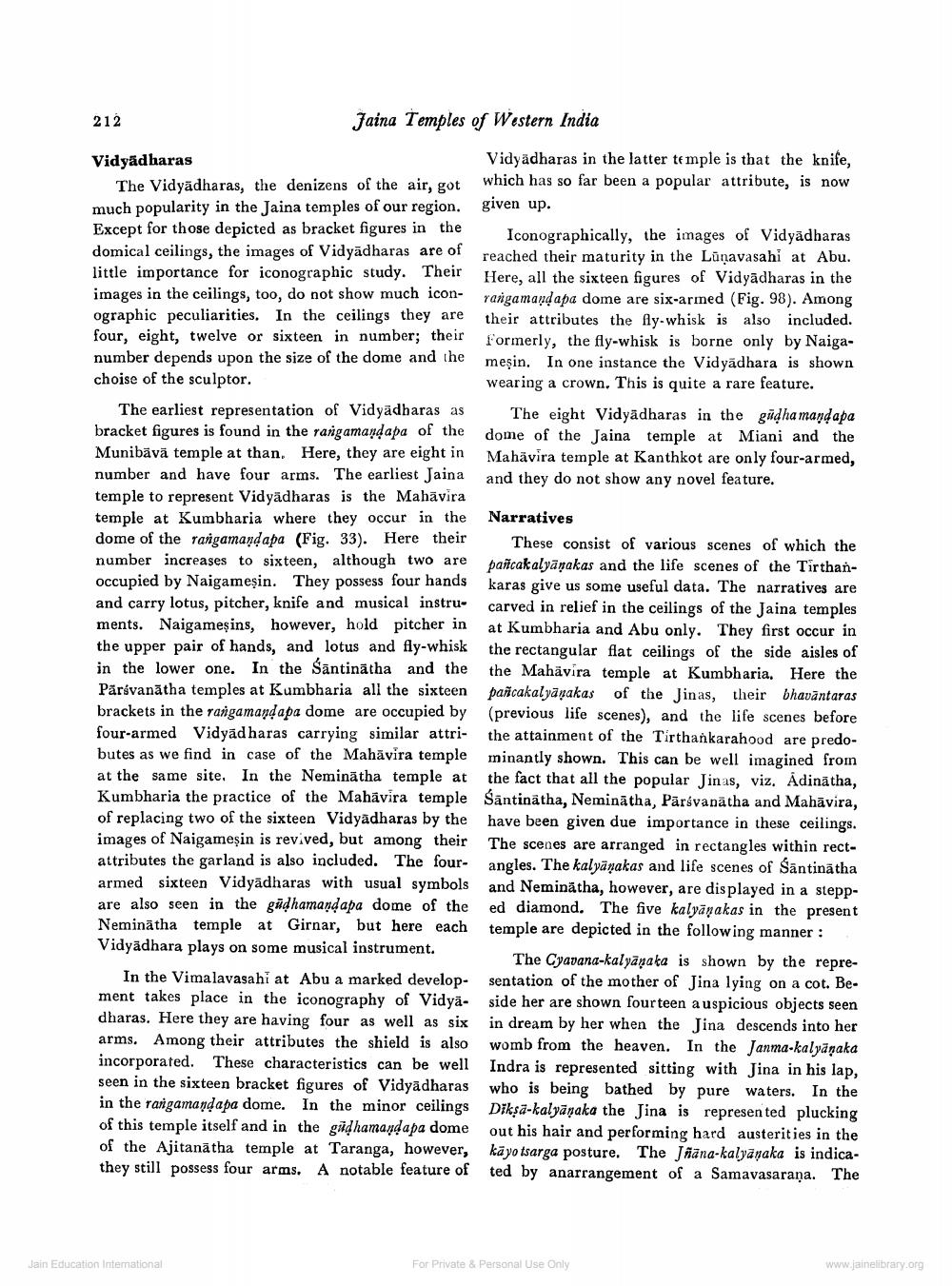________________
212
Jaina Temples of Western India
Vidyadharas
The Vidyadharas, the denizens of the air, got much popularity in the Jaina temples of our region. Except for those depicted as bracket figures in the domical ceilings, the images of Vidyadharas are of little importance for iconographic study. Their images in the ceilings, too, do not show much iconographic peculiarities. In the ceilings they are four, eight, twelve or sixteen in number; their number depends upon the size of the dome and the choise of the sculptor.
The earliest representation of Vidyadharas as bracket figures is found in the rangamandapa of the Munibävä temple at than. Here, they are eight in number and have four arms. The earliest Jaina temple to represent Vidyadharas is the Mahavira temple at Kumbharia where they occur in the dome of the rangamanḍapa (Fig. 33). Here their number increases to sixteen, although two are occupied by Naigameşin. They possess four hands and carry lotus, pitcher, knife and musical instruments. Naigameșins, however, hold pitcher in the upper pair of hands, and lotus and fly-whisk in the lower one. In the Santinatha and the Pärivanatha temples at Kumbharia all the sixteen brackets in the rangamandapa dome are occupied by four-armed Vidyadharas carrying similar attributes as we find in case of the Mahavira temple at the same site. In the Neminatha temple at Kumbharia the practice of the Mahavira temple of replacing two of the sixteen Vidyadharas by the images of Naigameşin is revived, but among their attributes the garland is also included. The fourarmed sixteen Vidyadharas with usual symbols are also seen in the gudhamandapa dome of the Neminatha temple at Girnar, but here each Vidyadhara plays on some musical instrument.
In the Vimalavasahi at Abu a marked development takes place in the iconography of Vidyadharas. Here they are having four as well as six arms. Among their attributes the shield is also incorporated. These characteristics can be well seen in the sixteen bracket figures of Vidyadharas in the rangamandapa dome. In the minor ceilings of this temple itself and in the gudhamandapa dome of the Ajitanatha temple at Taranga, however, they still possess four arms. A notable feature of
Jain Education International
Vidyadharas in the latter temple is that the knife, which has so far been a popular attribute, is now given up.
Iconographically, the images of Vidyadharas reached their maturity in the Lunavasahi at Abu. Here, all the sixteen figures of Vidyadharas in the rangamanḍapa dome are six-armed (Fig. 98). Among their attributes the fly-whisk is also included. formerly, the fly-whisk is borne only by Naigameşin. In one instance the Vidyadhara is shown wearing a crown. This is quite a rare feature.
The eight Vidyadharas in the gaḍhamandapa dome of the Jaina temple at Miani and the Mahavira temple at Kanthkot are only four-armed, and they do not show any novel feature.
Narratives
These consist of various scenes of which the pañcakalyāṇakas and the life scenes of the Tirthankaras give us some useful data. The narratives are carved in relief in the ceilings of the Jaina temples at Kumbharia and Abu only. They first occur in the rectangular flat ceilings of the side aisles of the Mahavira temple at Kumbharia. Here the pañcakalyaṇakas of the Jinas, their bhavantaras (previous life scenes), and the life scenes before the attainment of the Tirthankarahood are predominantly shown. This can be well imagined from the fact that all the popular Jinas, viz. Adinatha, Santinātha, Neminatha, Parsvanatha and Mahavira, have been given due importance in these ceilings. The scenes are arranged in rectangles within rectangles. The kalyaṇakas and life scenes of Śantinatha and Neminatha, however, are displayed in a stepped diamond. The five kalyanakas in the present temple are depicted in the following manner :
The Cyavana-kalyanaka is shown by the representation of the mother of Jina lying on a cot. Beside her are shown fourteen auspicious objects seen in dream by her when the Jina descends into her womb from the heaven. In the Janma-kalyaṇaka Indra is represented sitting with Jina in his lap, who is being bathed by pure waters. In the Diksä-kalyaṇaka the Jina is represented plucking out his hair and performing hard austerities in the kayo tsarga posture. The Jääna-kalyanaka is indicated by anarrangement of a Samavasaraṇa. The
For Private & Personal Use Only
www.jainelibrary.org




